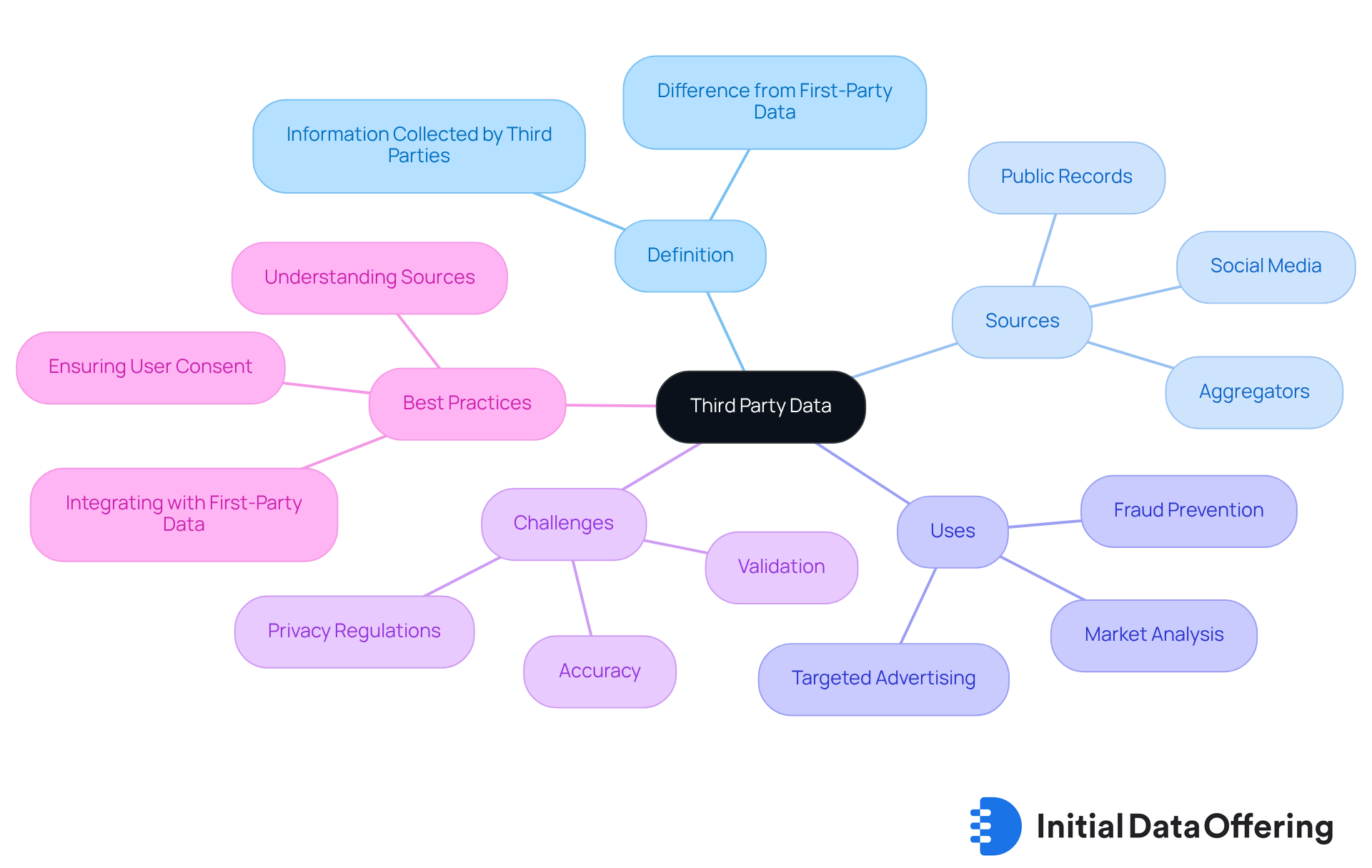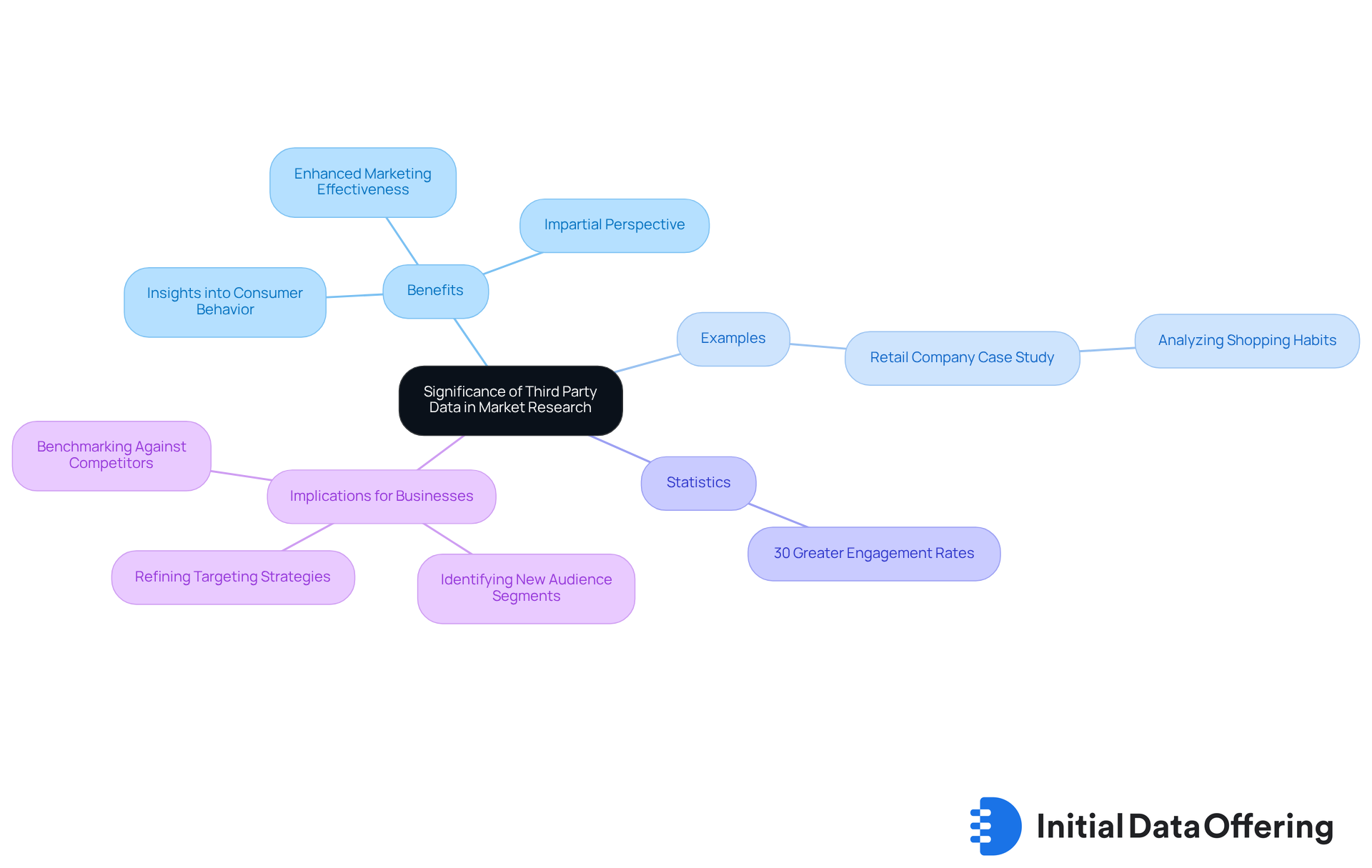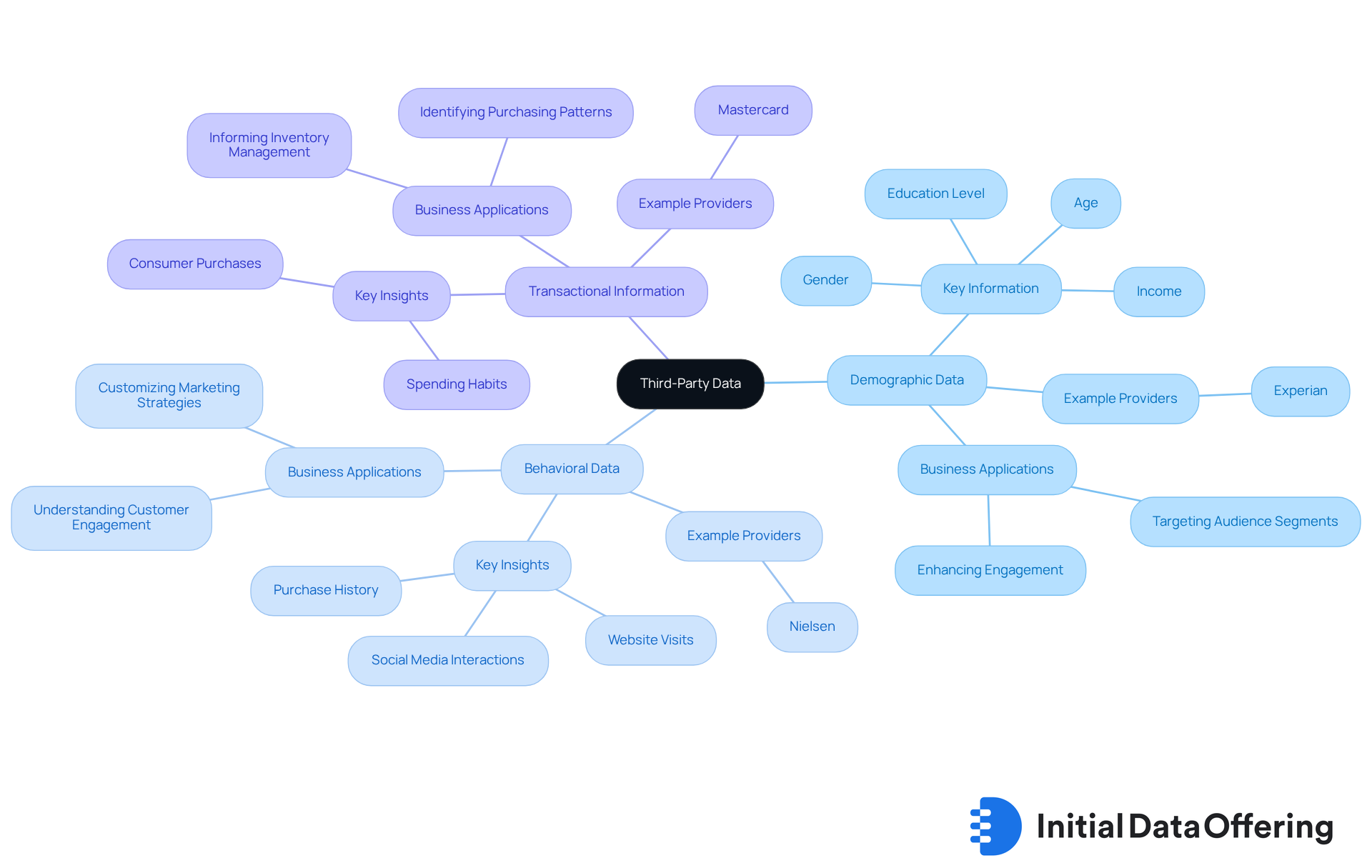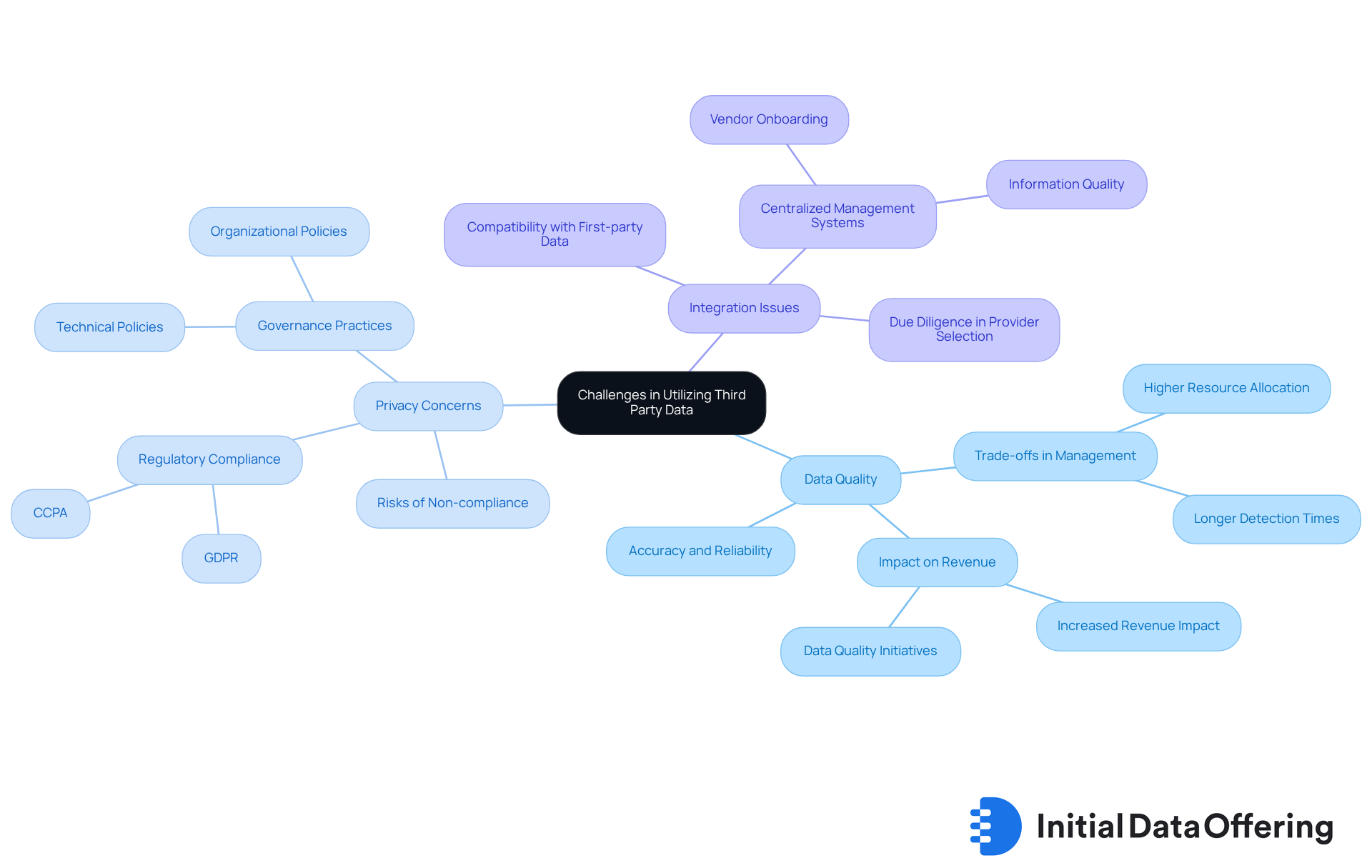What is Third Party Data? Key Insights and Practical Examples

What is Third Party Data? Key Insights and Practical Examples
Overview
Third-party data refers to information collected by organizations that do not have a direct relationship with the individuals whose data they gather, sourced from various platforms and brokers. This type of data is crucial in market research, offering insights into consumer behavior and trends. However, organizations face challenges regarding data quality, privacy compliance, and the integration of this data with first-party sources. Navigating these challenges is essential for effectively leveraging third-party data.
How can organizations ensure they are making the most of this valuable resource while addressing these concerns?
Introduction
Understanding the complexities of consumer behavior and market dynamics is crucial for businesses aiming to stay competitive. Third-party data, which encompasses information collected by external organizations without direct interaction with individuals, presents a wealth of insights that can significantly enhance marketing strategies.
The advantages of leveraging this data include:
- Improved targeting and personalization in marketing efforts.
- Enhanced understanding of consumer preferences and trends.
- Increased efficiency in marketing campaigns.
However, as companies increasingly rely on this external information, they face challenges related to:
- Data quality.
- Privacy regulations.
- Ethical considerations.
How can organizations effectively harness third-party data while navigating these complexities to drive better decision-making and foster consumer trust?
Define Third Party Data: Understanding Its Core Concept
Third-party information comprises details collected by organizations that lack a direct connection with the individuals whose information is gathered. This information is typically compiled from , including public records, social media platforms, and other companies. In contrast to first-party information, which companies gather directly from their clients, external information is obtained from aggregators or brokers who compile and sell this content. This category can encompass demographic details, online behaviors, and preferences, providing a comprehensive view of potential customers.
A considerable portion of companies relies on external information for market analysis, often using it to address deficiencies in their first-party information. For instance, businesses that are unfamiliar with the sector or those lacking information-gathering products frequently depend on external sources to guide their advertising strategies. This dependence is underscored by the fact that 56% of companies would prefer to forgo external information if superior options were available, highlighting persistent challenges related to accuracy and validation.
Successful instances of external information utilization include targeted advertising campaigns that leverage aggregated consumer behavior insights to improve marketing efficiency. Organizations often employ external information to track and prevent unusual activities, ensuring the integrity of their advertising procedures. By integrating external information with first-party sources, organizations can achieve more reliable insights into customer preferences and behaviors, ultimately resulting in enhanced advertising outcomes. SavvyIQ's AI-driven APIs can significantly improve this process by providing high-quality datasets that enhance the precision and efficiency of external applications.
However, the quality of external information can vary significantly, with limitations and potential biases often emerging post-acquisition. Therefore, companies are advised to handle external information with care, ensuring they understand its sources and the validation procedures involved. In the evolving landscape of information privacy, specialists emphasize what is third-party data and the importance of transparency in the practices of collecting such information. Organizations must navigate the complexities of privacy regulations while ensuring that user consent is respected and communicated effectively. This careful approach not only fosters trust but also enhances the overall effectiveness of data-driven strategies.

Explore the Significance of Third Party Data in Market Research
In market research, understanding [what is third party data](https://emarketer.com/topics/category/third-party data) is crucial, as it allows businesses to gain insights into consumer behavior and market trends that may not be accessible through internal sources alone. This underscores the advantage of utilizing external data, as W. Edwards Deming aptly noted, "." The benefit of this approach is clear: companies can identify new audience segments, refine their targeting strategies, and enhance overall marketing effectiveness.
For example, a retail company might analyze external information to explore shopping habits across various demographics. This enables the creation of more customized and effective marketing campaigns. Furthermore, utilizing external data provides a benchmark for companies to evaluate their performance against competitors and discover new market opportunities. Statistics reveal that businesses leveraging external information for audience segmentation experience significantly higher engagement rates; specifically, those that utilize extensive information sources report engagement rates up to 30% greater than those relying solely on internal resources. This emphasizes the importance of integrating diverse information sources, such as what is third party data, into marketing strategies.
Additionally, while internal research may carry the risk of bias due to internal influences, external information offers an impartial perspective. This enhances marketing initiatives and fosters informed decision-making and innovation across various sectors. How might your organization benefit from incorporating external data into its marketing strategies?

Identify Sources and Types of Third Party Data: Practical Examples
Third-party information is sourced from a diverse array of providers, including brokers, market research companies, and online platforms. The primary types of third-party data help to explain what is third-party data and encompass several key categories that provide valuable insights for businesses.
- Demographic Data: This category includes essential information such as age, gender, income, and education level, often derived from public records or surveys. For instance, companies like Experian utilize demographic information to assist businesses in effectively targeting specific audience segments. By leveraging this data, organizations can tailor their marketing strategies to reach the right consumers, enhancing engagement and conversion rates.
- Behavioral Data: Insights into consumer actions, such as website visits, purchase history, and social media interactions, are captured through cookies and tracking technologies. This type of information is crucial for understanding and preferences. For example, Nielsen employs behavioral information to offer insights into consumer habits, allowing brands to customize their marketing strategies. How can your organization utilize behavioral data to refine its approach?
- Transactional Information: This relates to consumer purchases and is often aggregated from multiple retailers, offering insights into spending habits. Organizations such as Mastercard examine transactional information to assist enterprises in grasping trends and consumer behavior. By analyzing this data, companies can identify purchasing patterns, which can inform inventory management and promotional efforts.
In 2025, prominent third-party information providers, like Acxiom, are anticipated to sustain substantial market shares by providing extensive information solutions that improve marketing strategies, illustrating what is third-party data. Acxiom, for instance, specializes in collecting consumer information from various sources, enabling businesses to acquire detailed profiles that can greatly enhance targeting and personalization efforts. As privacy regulations evolve, including GDPR and CCPA, these companies are modifying their information collection methods to ensure compliance while still providing valuable insights. Moreover, the increasing consumer hesitance to share information due to privacy issues underscores the significance of transparency and ethical practices in the current environment. How is your organization adapting to these changes to maintain consumer trust?

Examine Challenges and Considerations in Utilizing Third Party Data
While , or what is third party data, offers numerous advantages, it also presents significant challenges and considerations that organizations must navigate.
- Data Quality: The accuracy and reliability of third-party data can vary widely, leading to potential misinterpretations if the data is outdated or incorrect. Organizations that rely heavily on external information often face a tradeoff between information downtime and the time invested in ensuring quality. For example, companies managing a larger number of information tables tend to report lower average times for identifying and addressing issues. However, they allocate a greater percentage of their resources to quality management. Conversely, organizations with fewer tables spend less time on information quality but experience higher average times for detection and resolution, highlighting the complexities involved in managing information effectively.
- Privacy concerns related to what is third party data have increased, as businesses must ensure that their use of this information complies with legal standards in light of stringent regulations such as GDPR and CCPA to avoid substantial penalties. A well-managed information system can provide a single source of truth throughout an organization, streamlining evidence-based decision-making and minimizing misinformation. As privacy regulations evolve, organizations must remain vigilant in their governance practices, which should encompass both technical and organizational policies to safeguard sensitive information and ensure compliance.
- Integration Issues: Understanding what is third party data is essential, as combining it with first-party data can be complex, necessitating robust management systems to ensure compatibility and usability. Firms such as Unilever have effectively adopted centralized information management processes to enhance information quality and simplify integration, achieving centralized information points and reduced vendor onboarding time. This underscores the importance of a unified information strategy in addressing integration challenges.
For instance, while external information can enhance audience targeting and market insights, it may also present compliance risks if not managed appropriately. Therefore, businesses must conduct thorough due diligence when selecting third-party data providers and continuously monitor what is third party data to ensure its quality and relevance. This proactive approach not only mitigates risks but also enhances the overall effectiveness of data-driven initiatives.

Conclusion
Third-party data plays a pivotal role in modern marketing and business strategies, providing organizations with essential insights that would otherwise remain inaccessible. Understanding what third-party data entails allows companies to harness external information, enhancing their marketing effectiveness, identifying new audience segments, and making informed decisions based on comprehensive consumer behavior analysis.
This article highlights several key aspects of third-party data, including its:
- Definition
- Sources
- Types
- Challenges associated with its use
From demographic and behavioral data to transactional information, each category offers unique insights that can significantly improve marketing strategies. However, potential pitfalls, such as:
- Data quality issues
- Privacy concerns
- Integration challenges
must be navigated carefully to ensure compliance and maintain consumer trust.
As organizations increasingly rely on external data to drive their strategies, adopting a transparent and ethical approach to data collection and usage becomes crucial. By prioritizing data quality and compliance with privacy regulations, businesses can enhance their marketing initiatives while building lasting relationships with consumers. Embracing third-party data thoughtfully can lead to innovative solutions and improved outcomes in an ever-evolving marketplace.
Frequently Asked Questions
What is third-party data?
Third-party data refers to information collected by organizations that do not have a direct relationship with the individuals whose data is being gathered. This data is compiled from various sources such as public records, social media, and other companies.
How does third-party data differ from first-party data?
First-party data is information collected directly from clients by a company, while third-party data is obtained from aggregators or brokers who compile and sell this information.
Why do companies rely on third-party data?
Companies often rely on third-party data for market analysis to supplement their first-party data, especially when they lack sufficient information-gathering capabilities or industry knowledge.
What percentage of companies would prefer to avoid third-party data if better options were available?
56% of companies would prefer to forgo third-party data if superior alternatives were available, indicating challenges related to accuracy and validation.
How is third-party data used in advertising?
Third-party data is used in targeted advertising campaigns by leveraging aggregated consumer behavior insights to enhance marketing efficiency and track unusual activities to maintain advertising integrity.
What role do AI-driven APIs, like those from SavvyIQ, play in utilizing third-party data?
SavvyIQ's AI-driven APIs provide high-quality datasets that improve the precision and efficiency of external applications, aiding organizations in better integrating third-party data with first-party sources.
What are the potential issues with third-party data quality?
The quality of third-party data can vary significantly, with limitations and potential biases emerging after acquisition, making it essential for companies to understand the sources and validation processes involved.
What should organizations consider regarding privacy when using third-party data?
Organizations must navigate privacy regulations and ensure user consent is respected and communicated effectively, fostering trust and enhancing the effectiveness of data-driven strategies.